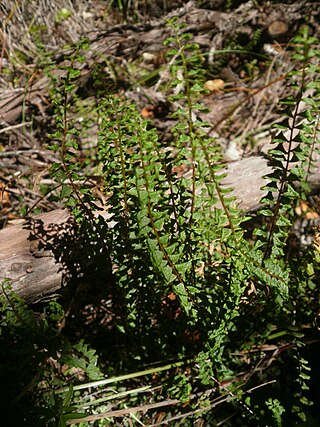
Cibotium, also known as manfern, is a genus of 11 species of tropical tree ferns. It is the only genus in family Cibotiaceae in the Pteridophyte Phylogeny Group classification of 2016. Alternatively, the family may be treated as the subfamily Cibotioideae of a very broadly defined family Cyatheaceae, the family placement used for the genus in Plants of the World Online as of November 2019.

Tripterygium wilfordii, or léi gōng téng (Mandarin), sometimes called thunder god vine but more properly translated thunder duke vine, is a vine used in traditional Chinese medicine.

Dennstaedtiaceae is one of fifteen families in the order Polypodiales, the most derived families within monilophytes (ferns). It comprises 10 genera with ca 240 known species, including one of the world's most abundant fern, Pteridium aquilinum (bracken). Members of the order generally have large, highly divided leaves and have either small, round intramarginal sori with cup-shaped indusia or linear marginal sori with a false indusium formed from the reflexed leaf margin. The morphological diversity among members of the order has confused past taxonomy, but recent molecular studies have supported the monophyly of the order and the family. The reclassification of Dennstaedtiaceae and the rest of the monilophytes was published in 2006, so most of the available literature is not updated.

Polystichum is a genus of ferns in the family Dryopteridaceae, subfamily Dryopteridoideae, according to the Pteridophyte Phylogeny Group classification of 2016. The genus has about 500 species and has a cosmopolitan distribution. The highest diversity is in eastern Asia, with about 208 species in China alone; the region from Mexico to Brazil has at least 100 additional species; Africa, North America, and Europe have much lower diversity. Polystichum species are terrestrial or rock-dwelling ferns of warm-temperate and montane-tropical regions. They are often found in disturbed habitats such as road cuts, talus slopes, and stream banks.

Woodwardia is a genus of ferns in the family Blechnaceae, in the suborder Aspleniineae of the order Polypodiales. Species are known as chain ferns. The genus is native to warm temperate and subtropical regions of the Northern Hemisphere. They are large ferns, with fronds growing to 50–300 cm long depending on the species. The fossil record of the genus extends to the Paleocene.

Dennstaedtia is a mostly tropical and subtropical genus of ferns described as a genus in 1801. Hayscented fern, or Cup ferns, are common names for some species in this genus. Its best-known member is probably the temperate North-American hay-scented fern, Dennstaedtia punctilobula, which forms extensive clonal ground-cover colonies on level surfaces in the Appalachian area.

Hymenophyllum is a genus of ferns in the family Hymenophyllaceae. Its name means "membranous leaf", referring to the very thin translucent tissue of the fronds, which gives rise to the common name filmy fern for this and other thin-leaved ferns. The leaves are generally only one cell thick and lack stomata, making them vulnerable to desiccation. Consequently, they are found only in very humid areas, such as in moist forests and among sheltered rocks. They are small and easy to overlook.

Lindsaeaceae is a pantropical family of ferns in the order Polypodiales. It contains six or seven genera with about 220 known species, some of which also extend into the more temperate regions of eastern Asia, New Zealand, and South America.

Calochlaena dubia, commonly known as soft bracken, false bracken, common ground fern or rainbow fern, is a small Australian fern in the treefern family Dicksoniaceae. It is very common within its range, and often seen growing under eucalyptus forest, often on the poorer quality soils. It is an easy plant to grow in the garden.

Dennstaedtia bipinnata common names the cuplet fern, cuplet hay-scented fern is a species of fern in the family Dennstaedtiaceae.
Lonchitis is a neotropical genus of ferns. It is the sole genus in the family Lonchitidaceae. At one time Lonchitis was placed in the Dennstaedtiaceae, and then transferred to the Lindsaeaceae, before being placed in its own family.

Histiopteris is a genus of ferns in the family Dennstaedtiaceae described as a genus in 1875.
Oenotrichia is a genus of ferns in the family Dennstaedtiaceae in the major group Pteridophytes, and was described as a genus in 1929. It is native to New Caledonia.

Microlepia is a genus of ferns in the family Dennstaedtiaceae described as a genus in 1836. Most of the species are native to Asia, with many endemic to China, although a few species occur also in Australia, Africa, the West Indies, Latin America, and various oceanic islands.

Paesia is a genus of large, coarse ferns in the family Dennstaedtiaceae described as a genus in 1833. Species are known from South America, Central America, East Asia, and New Caledonia.
- Paesia acclivis(Kunze) Kuhn - Venezuela, Colombia, Ecuador, Peru
- Paesia amazonica(Christ) C. Chr. - Loreto Region in Peru
- Paesia anfractuosa(Christ) C. Chr. - Panama, Costa Rica
- Paesia glandulosa(Sw.) Kuhn - Panama, Costa Rica, Venezuela, Colombia, Ecuador, Peru, Bolivia
- Paesia rugulosa(Labill.) Kuhn - Vietnam, New Caledonia
- Paesia scalaris(Mett.) Kuhn
- Paesia taiwanensisW.C. Shieh - Taiwan
Hypolepis poeppigii is a fern species in the family Dennstaedtiaceae that has no common name.
August Wilhelm Dennstedt (1776–1826), surname sometimes spelled Dennstaedt, was a German physician and botanist who was bürgermeister of Magdala, a town near Weimar. From 1817 he was scientific director of the Grand Ducal Garden in Belvedere.

Dipteris is a genus of about seven species of ferns, native to tropical regions across the world, particularly Asia, with a species in northeastern Queensland in Australia. It is one of two genera in the family Dipteridaceae.
Stegnogramma is a genus of ferns in the subfamily Thelypteridoideae of the family Thelypteridaceae in the Pteridophyte Phylogeny Group classification of 2016. Other sources sink Stegnogramma into a very broadly defined genus Thelypteris.

The Platygloeales are an order of rust fungi in the class Pucciniomycetes. It contains two families, the Eocronartiaceae and also the Platygloeaceae.















